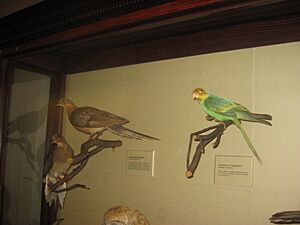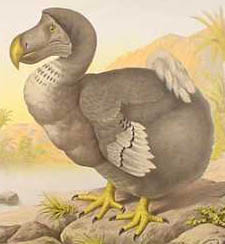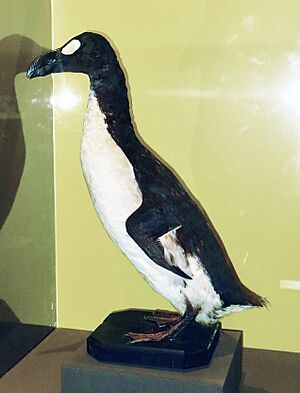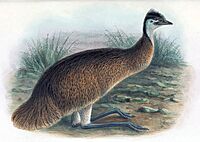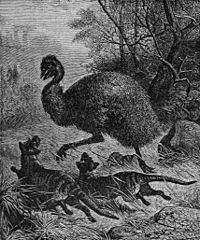Bird extinction facts for kids
Bird extinction means that all members of a certain type of bird have completely disappeared from Earth. Out of about 11,154 known bird species, 159 (which is 1.4%) have become extinct. Another 226 (2%) are critically endangered, meaning they are very close to disappearing forever. Many bird experts believe that if human activities continue as they are, about one-third of all bird species could be gone by the end of this century.
For birds that are critically endangered, scientists think they might disappear in just a few decades if we don't help them. For some of these birds, we're not even sure if any are still alive today.
Contents
Why Birds Disappear
Birds often face many problems at once. But the biggest reasons for birds disappearing are losing their homes, being hunted too much, and new species arriving that don't belong. Birds that live only on islands are especially sensitive to these problems. Since the late 1400s, 95% of bird extinctions have been island birds.
Losing their homes has a big impact on birds. For example, cutting down forests affects about 70% of all known bird types. Smaller birds are often hurt more by losing their homes. Bigger birds are more often endangered by human hunting and new species.
Losing Their Homes
When birds lose their homes completely, it's very bad for them. But even when their homes are just broken up into smaller pieces, it can still cause extinction. For example, the Wood thrush is not endangered, but its numbers have dropped a lot because its forest home is now in pieces.
The Brown-headed cowbird is a bird that lays its eggs in other birds' nests. It is much more common in smaller forest areas. This change has made the Wood Thrush and other forest songbirds more likely to have their nests taken over, which lowers their populations.
Too Much Hunting
Hunting and collecting eggs can also lead to birds disappearing. People hunt birds for their feathers, meat, or to stuff them for display. While these activities aren't always bad, taking too many birds can seriously harm their populations. This can lead to them disappearing from an area or even completely from Earth.
Even though people might think hunting birds too much is an old problem, it still happens today. This is true even with laws to protect wildlife. The Ortolan Bunting, a small songbird, is hunted illegally in France because it's seen as a special food. This bird is now very close to disappearing. The pet trade also causes many birds to disappear, especially parrots. This illegal hunting was the main reason the Spix's macaw disappeared from the wild.
New Species Moving In
New species that move into an area can be a big danger to birds. Birds that live in only one small area, like on an island, are at even greater risk. These new species, like pigs or rats, often harm birds by eating their eggs or young on the ground. Many island birds have never faced these kinds of predators before, so they don't know how to defend themselves.
For example, the Kākāpō is a very rare parrot from New Zealand. Its only way to hide from predators is to stay very still. This works against native predators like hawks. But it doesn't help against new mammals like rats, cats, and stoats that were brought to New Zealand.
Many bird extinctions linked to diseases also happen because of new species. Hawaiian honeycreepers are a good example. These finches, native to Hawaii, are harmed by bird malaria. This disease spread to them when the southern house mosquito, which carries the disease, arrived in Hawaii.
Famous Examples
Dodo
The Dodo is probably one of the most famous extinct birds. It was a plump, flightless bird related to doves. Dodos lived only on the island of Mauritius in the Indian Ocean. Because they had plenty of food and no predators on their isolated island, they evolved to be large and couldn't fly.
When the Dutch arrived on Mauritius in the late 1400s, they saw and wrote about the Dodo. The birds were easy to catch and had a lot of meat, making them a good food source for sailors. While hunting hurt their numbers, new animals brought to the island likely played a bigger role in their extinction. Pigs, for example, did very well on Mauritius. They probably ate young dodos and competed with adult dodos for food. Along with losing their homes and many more new species arriving, the Dodo likely disappeared in the late 1600s. Its quick extinction shows how easily island birds can disappear. The Dodo is now a symbol of how human activities can cause extinctions.
Great Auk
The Great auk, sometimes called the "Penguin of the North," was a flightless seabird. It lived in the North Atlantic Ocean and nearby islands. Its home once stretched to the United States and Europe. But by the 1800s, it only bred on a few rocky islands in the North Atlantic.
Hunters wanted the Great Auk for its valuable skins, eggs, and down feathers. They hunted the birds when they gathered in large groups to nest on rocky islands. It was much harder to hunt them when they weren't breeding. At those times, they were spread out and spent most of their time in the cold ocean, where they were fast swimmers. The last known Great Auks were seen and killed in 1844 by fishermen. They hoped to sell the birds' valuable skins. The Great Auk is believed to have disappeared around this time.
Passenger Pigeon
The passenger pigeon was a bird that lived in huge flocks and was once very common in North America. Before Europeans arrived, Passenger Pigeons might have made up 40% of all birds on the continent. The main reasons they disappeared were losing their homes and being hunted too much.
Besides human activities, the cutting down of forests that hurt Passenger Pigeons was also made worse by a disease called chestnut blight. This disease greatly reduced the number of American chestnut trees in North America. Because there were so many Passenger Pigeons and they gathered in huge groups, they were an easy target for hunters. People thought there were so many that they didn't need protection. Birds were killed in huge numbers, and a big pigeon meat business grew. Some laws were made to protect the declining Passenger Pigeon, but they didn't help much. Because they bred in such large groups, trying to breed them in zoos was almost impossible. Their numbers kept dropping. The Passenger Pigeon was declared extinct in 1914. This happened when the last known bird, Martha, died at the Cincinnati Zoo. This was 20 years after the species disappeared from the wild. The Passenger Pigeon is one of the few recently extinct birds that scientists hope to bring back using special genetic methods.
Carolina Parakeet
The Carolina parakeet, also called the Carolina parrot, was native to and very common in the eastern United States. These birds ate many farm crops, which made local farmers very angry. This, along with people wanting their colorful feathers, led to massive killing efforts. Large numbers of deaths and loss of their homes wiped out their populations. The Carolina Parakeet was declared extinct in the early 1920s. The last known bird, a male named Incas, died at the Cincinnati Zoo in 1918.
Tasmanian Emu
The Tasmanian emu was a type of Emu bird that lived only in Tasmania, Australia. Compared to other Emus, Tasmanian Emus were thought to be smaller and had darker feathers, without the black feathers seen in other Emus. Records show that the Tasmanian Emu disappeared from its home in just 20 years, between the 1830s and 1850s. This happened because of several reasons that led to this type of Emu disappearing.
See Also


